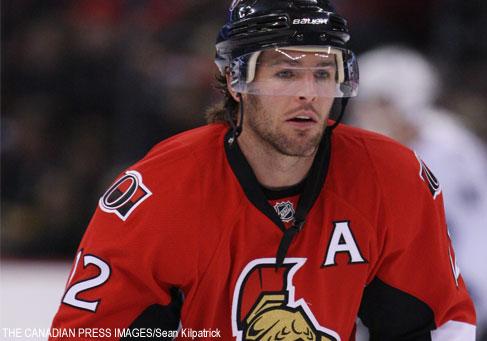“Mike Fisher isn’t really a No. 2 centre. He’s a great third-line centre, masquerading as a top-six forward.”.
That statement has been uttered by every single Ottawa Senators fan at some point in the past 18 months. (Other popular lines inside Scotiabank Place include, “When are we getting a new scoreboard?” and “Hey – sit down and stop clapping. You’re ruining it for everyone.”)
Fisher, according to the vast majority of Ottawa fans, is a gritty centreman who doesn’t put up the offensive numbers generally associated with players in the top six. But because Fisher is being paid like a top-six forward ($4.2 million cap hit), head coach Cory Clouston has to pencil him in as the No. 2 centre every night.
There is only one problem with this line of thinking: It’s completely false.
Not only is Fisher a legitimate second-line centre — he’s one of the better ones in the NHL. And yes, I’m speaking of Fisher from an offensive standpoint.
Somehow in this twisted world of ours, we’ve created a bizarre set of unrealistic expectations for our second-line centres. We expect them to be playmakers who are offensively gifted. A lot of us are still stuck in the early 1990s mode of thinking when second-line centres were guys like Ron Francis, Craig Janney, John Cullen and Sergei Fedorov. When the Habs won their Stanley Cup in 1993, their second-line centre was Stephane Lebeau, who racked up 80 points during the regular season.
Even after the high-scoring days of the early 1990s ended, we expected second-line centres to be offensively-oriented. A perfect example was a guy like Andrew Cassels, who was seemingly the answer to every team’s second-line woes on trade deadline day. Cassels continued to perpetuate the stereotype of the soft, play-making centre who needed to be the anchor of the second line. That is the image that many of us still have today.
But perception and reality are two different things.
Much like unicorns, Big Foot or a local investor for the Phoenix Coyotes, a second-line centre is a mythical creature. That idealized version of the No. 2 centre doesn’t exist in today’s NHL. We created him in our minds and we can’t seem to get rid of him.
To verify my claim, I decided to do a little bit of research, looking at the statistics from last year’s regular season. I added up the point totals for each team’s second-line centre and the numbers it yielded were interesting to say the least.
The average second-line centre in the NHL had the following statistical line from 2009-10:
18 goals
30 assists
48 points
My guess is that most people would predict those numbers would have been a bit higher. But try to remember, this isn’t 1994 anymore.
Fisher’s season total of 25-28-53 put him well ahead of the average second-line centre in goals. Fisher’s five-year average since the lockout has seen him produce an average of 21 goals and 45 points. (Numbers that would be higher if you removed his atypical 2008-09 season when he was an underachiever and suffered through an off-year. It’s safe to call him a fairly consistent 20-25 goal scorer in the NHL.)
Fisher’s offensive production put him alongside some of the best second-line centres in the NHL last season. He fits right in with the following list of players whom I feel are the best second-line centres in the game. (This includes players like Patrick Sharp and Danny Briere, who often switch between centre and wing, but for the purposes of this piece, I considered them centres).
Ryan Kesler: 25 goals, 75 points ($5 million cap hit)
Patrick Sharp: 25 goals, 66 points ($3.9 million)
Tim Connolly: 17 goals, 65 points ($4.5 million)
Brooks Laich: 25 goals, 59 points ($2.1 million)
Danny Briere: 26 goals, 53 points ($6.5 million)
Mike Fisher: 25 goals, 53 points ($4.2 million)
Patrice Bergeron: 19 goals, 52 points ($4.7 million)
Joe Pavelski: 25 goals, 51 points ($4 million)
There is a wide array of players who make up the second-line centres in the NHL. Some like Evgeni Malkin and Vincent Lecavalier are only second-line centres because they play behind Sidney Crosby and Steven Stamkos respectively. And there are others like Scott Gomez and Chris Drury who have been relegated to second-line status, even though they are paid like first liners.
But that group of players listed above represents established centres who are in the prime of their careers, with fairly well-defined roles as second-line centres. Suddenly, Fisher’s productivity and salary seem to be well in line with his counterparts around the league.
We need to change our perception of what we expect from a second-line centre. And once that is done, you will realize that Mike Fisher is a pretty good one.


